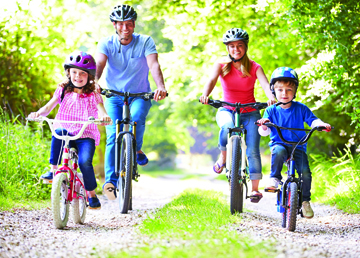by Nicholas Auger

Cycling is by far one of the best non-impact exercises around, and some of the most important aspects of cycling are in the details. Understanding them can help you turn biking from a childhood hobby into a key element of a healthy and active lifestyle. Here are four tips to get you started down the road.
ABC Bicycle Check
Before you get on any bicycle, run over the basic components of the bike and confirm they are working. The “ABC Check” is a universal approach.
A is for Air. Check that both wheels are inflated to a firm squeeze. If they’re low, check the side of the tire for the inflation number labeled as PSI, which will typically be 45 to 65 and can go up to 160.
B is for Brakes. Inspect the braking mechanism. It could be a hand lever on the handle bars or a coaster brake. Engage the brakes and try to move to see if the tires roll. They should not!
Lastly, C is for Chain. Pedal the cranks backward (or forward if you have coaster brakes) and check that the chain is intact and moves easily.
Manage Comfort
Make sure you’re comfortable on the bike! Bicycles have specific sizes and can be modified to fit many different riders. When you are on the bicycle, the seat should be high enough for your leg to almost fully extend. And typically, if on the saddle, you should be on your tippy toes to reach the ground. This will help you use your leg muscles in a more efficient way.
Adjust the handlebars, grips, and levers. A bicycle mechanic can help you make additional modifications. Cycling shorts with pads and thicker seats, as well as gloves and glasses, can provide quick improvements. Lastly, safety: Invest in a helmet that is less than eight years old and make sure it is comfortable.
Balance Your Body/Mind Connection
When you start a cycling routine, it’s common to overdo it at first, or to get quickly discouraged after a few hills. Cycling calls for strength to power major muscle groups, and cardiovascular endurance — both can leave you out of breath when you’re first starting out. This is where understanding the importance of breathing and a few breathing exercises can improve your performance before you get on the bike.
The first is Alternative Nostril Breathing or Anuloma Viloma. As a yoga movement, the exercise is designed to calm and stabilize your mind and body and balance the right and left side of the brain, which makes pedaling more even.
To do the exercise, take these steps:
• Begin in a comfortable, seated position in a chair or the floor with pillows.
• With one hand, make the “hang loose” sign with your pinky and thumb extended.
• Take in a full inhale through your nose.
• Using your thumb on the “hang loose” hand, close your right nostril and fully exhale out of your left nostril.
• Once the exhale is complete, keep your thumb in the same place and take a full inhale through your left nostril.
• Once the inhale is complete, use your pinky on that same hand to close the left nostril, keeping your thumb closing the right nostril. Hold your breath in with both nostrils closed.
• On the next inhale, remove your thumb and exhale fully out of the right nostril.
• Now inhale fully with your pinky closing the left side nostril.
Another exercise is known as the One-Minute Breath. Also performed off the bike, the exercise involves taking the least amount of breaths you can for one minute. First, sit comfortably and slow your breathing, focusing on all parts of the breath. Progressively lengthen the timing of each inhale and exhale, pausing and retaining your breath every time you breathe in and out.
Ride To The Rhythm …
Of Your Breath
Once on the bike, practicing breath cadence can keep you going the distance. To do this, count your breaths to the rhythm of your crank revolutions. For example, one inhale may last as long as four crank revolutions. Focusing on the pace of your breathing and your physical exertion syncs your breathing with your body, which helps regulate oxygen flow, control your heart rate, and boost your endurance.
Through cycling, you can improve strength and your overall health and push your fitness to new levels. Besides it’s just plain fun. Pedal on!
Nicholas found fitness through his BFA in sculpture. Now, instead of metal and wood, he focuses on enriching communities through creating programs that sculpt spirit, mind and body. Ten years of teaching yoga, kids yoga, group exercise, and personal fitness training has led him to the role of Health and Wellness Director at the Downtown Denver YMCA.
